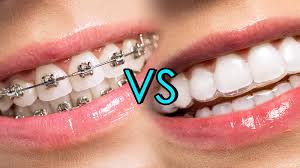Introduction
When it comes to choosing between Invisalign and traditional braces, there are a few key factors to consider. First and foremost is the desired outcome of the treatment. Both options can effectively straighten teeth and correct dental issues, but they may be better suited for different types of cases.
Invisalign is generally recommended for mild to moderate cases of misalignment, crowding, and spacing issues. It can also be used to treat some bite issues, such as overbite, underbite, and crossbite. However, for more complex dental issues or severe bite problems, traditional braces may be a more appropriate treatment option.
Understanding Invisalign and Traditional Braces
In order to make an informed decision about whether Invisalign or traditional braces are the right choice for you, it’s important to understand how each treatment works. Invisalign uses a series of clear aligners that are custom-made to fit over your teeth and gradually move them into their desired positions. However, Invisalign may be less effective for complex issues, as research suggests that it is more effective for people whose teeth require only certain kinds of movement. Your doctor may suggest another treatment option for more complex issues. Traditional braces, on the other hand, use metal wires and brackets to apply pressure to the teeth and guide them into alignment. However, with the advancements in technology, Invisalign now offers attachments that can help with more complex tooth movements, making them a viable option for those who may have previously needed clear braces.
The Basics of Invisalign
Invisalign is a popular choice for orthodontic treatment due to its discreet and convenient nature. The treatment process starts with a consultation with an Invisalign-trained dentist or orthodontist, who will assess your dental needs and determine if the Invisalign system from the American Association of Orthodontists is the right option for you. If so, a 3D image of your mouth and jaw will be taken to create a customized treatment plan.
The aligners themselves are made from a flexible thermoplastic material called SmartTrack. These clear aligners are virtually invisible and fit tightly over your teeth. You will be given a series of aligners to wear, with each set gradually moving your teeth closer to their desired positions. The aligners are typically worn for 20 to 22 hours a day, and you will switch to a new set of aligners every one to two weeks. This information has been gathered through a systematic review of various studies, including one by Rossini et al. (2015), which evaluated the efficacy of clear aligners in controlling orthodontic tooth movement and was published in the Journal of Orthodontics.
Invisalign treatment is made possible by Align Technology, the company behind the aligners. Align Technology uses advanced technology and software to create precise treatment plans and fabricate the aligners. This ensures that each aligner is customized to your unique dental needs and helps to achieve optimal results.
How Traditional Braces Work
Traditional braces have been used for many years as a reliable method for straightening teeth and correcting dental issues. They consist of metal brackets and wires that work together to apply pressure to the teeth and gradually move them into alignment.
The braces are affixed to the teeth using a special adhesive, and the wires are threaded through the brackets. The wires are then tightened periodically by the orthodontist to continue the process of tooth movement. This tightening creates tension in the wires and rubber bands, which applies pressure to the teeth and guides them into their desired positions.
The orthodontic tooth movement that occurs with traditional braces is a result of the continuous pressure applied by the wires. Over time, this pressure causes the bone surrounding the teeth to remodel, allowing the teeth to shift into their new positions with high efficacy. The process of tooth movement with traditional braces can take anywhere from several months to a few years, depending on the complexity of the case.
Benefits of Choosing Invisalign
Invisalign treatment offers several benefits that make it an attractive option for individuals seeking orthodontic treatment. Here are some key benefits of choosing Invisalign:
- Discreet appearance: Invisalign aligners are virtually invisible, making them a more discreet treatment option compared to traditional braces.
- Removable aligners: The clear aligners can be easily removed when eating, allowing for greater flexibility in food choices and easier maintenance of oral hygiene.
- Comfortable fit: Invisalign aligners are made from a smooth and flexible material, making them more comfortable and causing less irritation to the mouth compared to metal brackets and wires.
- Efficient treatment time: Invisalign treatment generally offers a shorter treatment time compared to traditional braces, allowing for faster results and less time spent wearing orthodontic appliances.
These benefits make Invisalign a popular choice for individuals who want to straighten their teeth without the visibility and inconvenience of traditional braces.
Advantages of Traditional Braces
Traditional braces have been used for many years and offer several advantages for orthodontic treatment. Here are some key advantages of traditional braces:
- Greater control over tooth movement: Traditional braces use metal brackets and wires to apply precise pressure to the teeth, allowing for more control over tooth movement and alignment.
- Effective for complex dental issues: Traditional braces are more effective for addressing complex orthodontic problems, such as severe crowding or bite issues.
- Durability: Metal brackets and wires used in traditional braces are durable and can withstand the forces required to move the teeth into the desired position.
These advantages make traditional braces a reliable and effective treatment option for individuals with more severe dental issues or those who require more precise tooth movement.
Making the Decision
When making a decision between Invisalign and traditional braces, it’s important to consider several factors. Here are some key factors to consider before choosing the right orthodontic treatment:
- Treatment option: Evaluate the advantages and disadvantages of Invisalign and traditional braces to determine which treatment option aligns with your specific dental needs and preferences.
- Consultation with a professional: Schedule a consultation with a dentist or orthodontist to assess your dental issues and receive professional advice on the best treatment option for you.
- Overall commitment: Assess your ability to comply with the treatment requirements, such as wearing aligners or maintaining traditional braces, to ensure the success of your orthodontic treatment.
By considering these factors and consulting with a dental professional, you can make an informed decision about the best treatment option for your dental needs.
Conclusion
In conclusion, the choice between Invisalign and traditional braces depends on various factors such as effectiveness, suitability for dental issues, lifestyle considerations, maintenance, duration of treatment, and personal preferences. Make an informed decision that aligns with your oral health goals and lifestyle. Contact us today at South Dayton Smiles for more!

 Meet Dr. Botti
Meet Dr. Botti
 Meet Dr. Scranton
Meet Dr. Scranton
 Our Team
Our Team
 Patient Forms
Patient Forms Online Bill Pay
Online Bill Pay Benefit Program
Benefit Program Your First Visit
Your First Visit